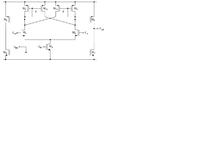student153
Member level 1
Comparator design
I am designing hysteresis comparator (see the attached schematic). I am facing a strange issue. Even when i make the cross coupled PMOS devices (M10, M11) equal in size to the diode connected load (M3, M4), i still get 13 mV of hysteresis and even if i reduce the size of M10, M11 than M3, M4 still i get 7-8mV of hysteresis. Does anybody have an idea whats going on here.

I am designing hysteresis comparator (see the attached schematic). I am facing a strange issue. Even when i make the cross coupled PMOS devices (M10, M11) equal in size to the diode connected load (M3, M4), i still get 13 mV of hysteresis and even if i reduce the size of M10, M11 than M3, M4 still i get 7-8mV of hysteresis. Does anybody have an idea whats going on here.
